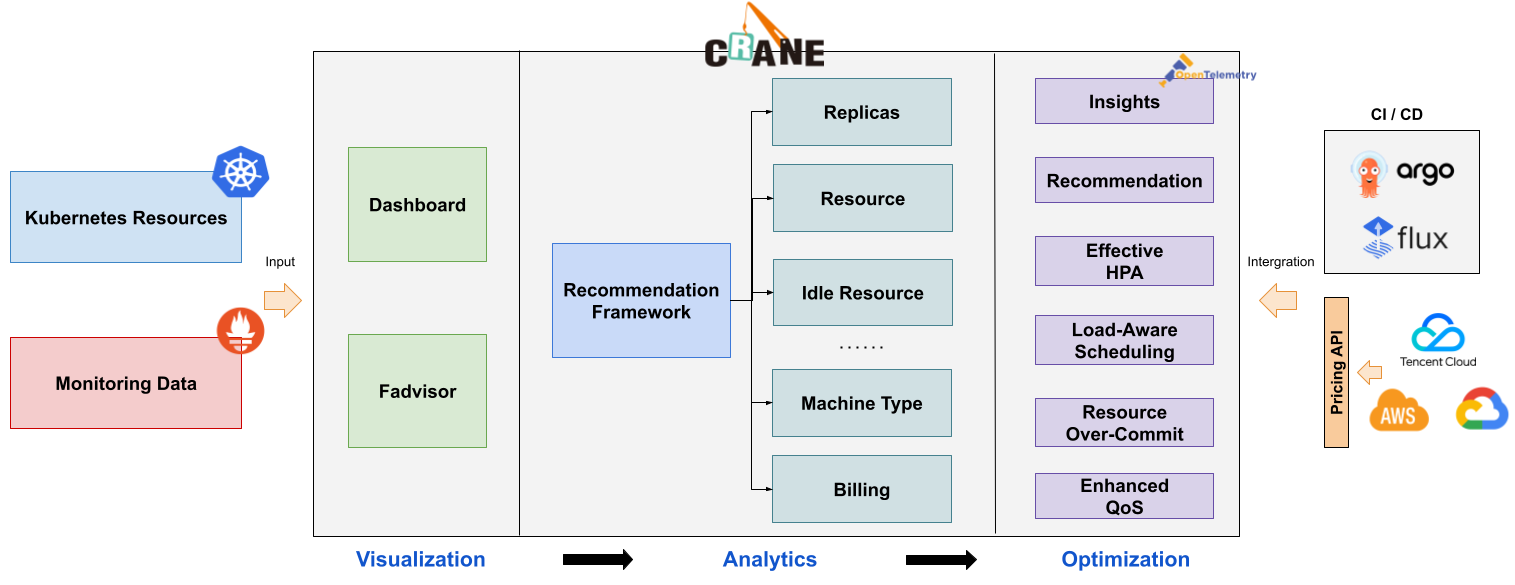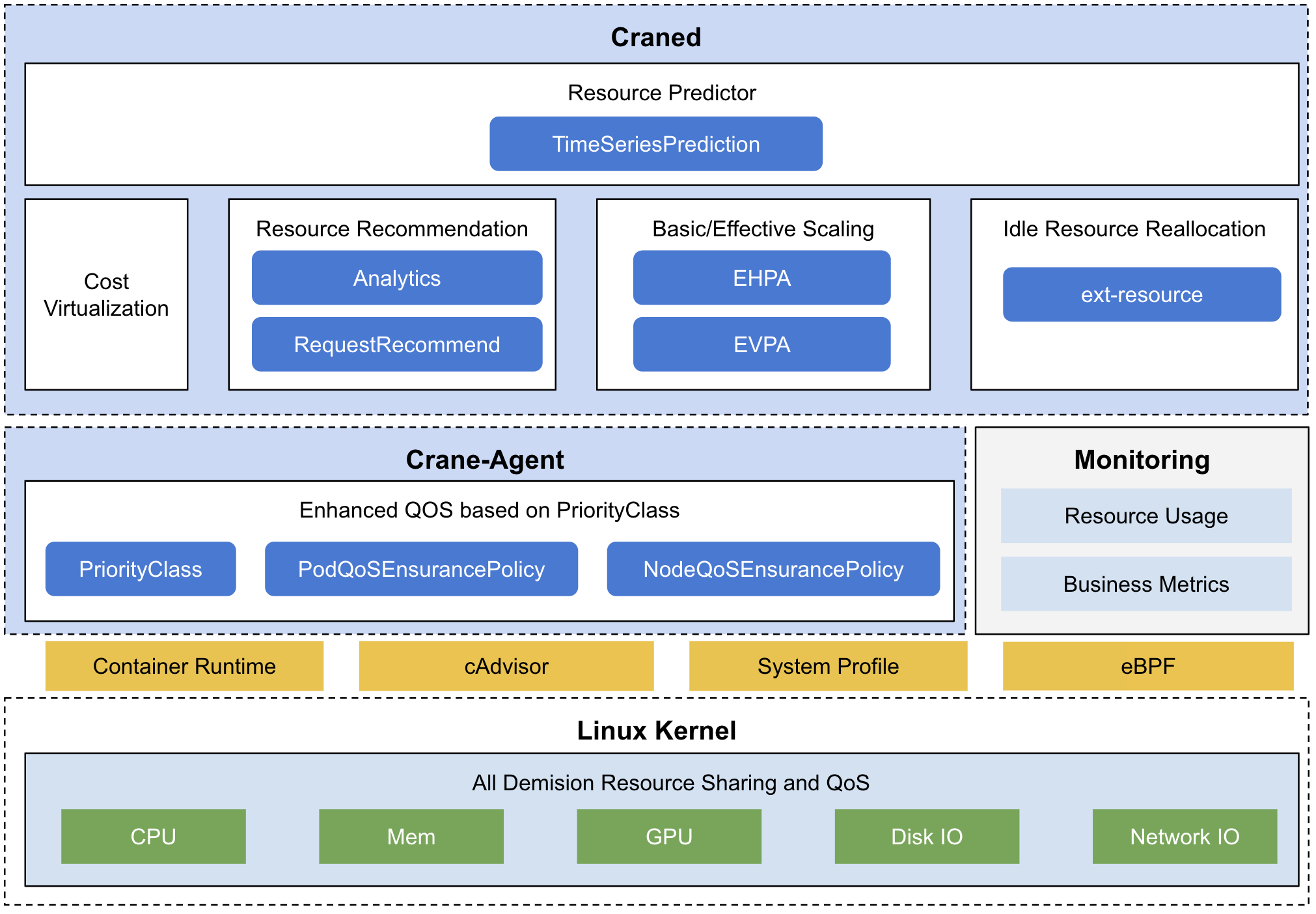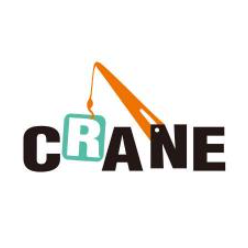What is Crane
English | Chinese
Crane is a FinOps-based cloud resource analysis and cost optimization platform. Its vision is to achieve the ultimate cost reduction on the premise of ensuring the quality of customer application operation.
How do I start a cost optimization journey in Crane?
- Cost display: Multi-dimensional aggregation and display of Kubernetes resources (Deployments, StatefulSets).
- cost analysis: Periodically analyze the status of cluster resources and provide optimization suggestions.
- cost optimization: The goal of cost reduction is achieved by updating the configuration with rich optimization tools.
Crane Dashboard Online Demo: http://dashboard.gocrane.io/
Main Features

Cost visualization and optimization evaluation
- Provides billing and billing data for a set of Exporter computing cluster cloud resources and stores it in your monitoring system, such as Prometheus.
- Multi-dimensional cost insights to optimize evaluation.pass
Cloud ProviderSupports multi-cloud billing.
Recommended Framework
Provides an extensible recommendation framework to support the analysis of multiple cloud resources, and has multiple built-in recommenders: resource recommendation, copy recommendation, and idle resource recommendation.understand more
Prediction-Based Horizontal Elasticity
EffectiveHorizontalPodAutoscaler enables prediction-driven resiliency. It does the underlying elasticity control based on community HPA, supports richer elasticity triggering strategies (prediction, observation, cycle), makes elasticity more efficient, and guarantees service quality.understand more
load-aware scheduler
The dynamic scheduler builds a simple but efficient model based on actual node utilization and filters out those nodes with high load to balance the cluster.understand more
QOS-based co-location
QOS-related capabilities ensure the stability of Pods running on Kubernetes. It has the ability of interference detection and active avoidance under the condition of multi-dimensional indicators, supports precise operation and custom indicator access; has the ability to oversell elastic resources enhanced by the prediction algorithm, reuse and limit the idle resources in the cluster; has the enhanced bypass cpuset management capabilities, and improve resource utilization efficiency while binding cores. understand more.
Architecture
The overall architecture of Crane is as follows:

Craned
Craned is the core component of Crane, it manages the life cycle of CRDs and API. Craned by Deployment is deployed and consists of two containers:
- Craned: Runs Operators to manage CRDs, provides WebApi to Dashboard, Predictors provides TimeSeries API
- Dashboard: A front-end project developed based on TDesign’s Starter scaffolding, providing easy-to-use product functions
Fadvisor
Fadvisor provides a set of exporter computing cluster cloud resources billing and billing data and stores it to your monitoring system, such as Prometheus. Fadvisor via Cloud Provider API that supports multi-cloud billing.
Metric Adapter
Metric Adapter implements a Custom Metric Apiserver. Metric Adapter reads CRDs information and provides Custom/External Metric API data from HPA Metrics.
Crane Agent
Crane Agent by DaemonSet Deployed on the nodes of the cluster.
quick start
Documentation
Check out the full documentation.
Community
Slack(English): https://gocrane.slack.com
WeChat group: After adding WeChat, reply “Crane”, and the assistant will regularly add you to the WeChat group.

- Bi-weekly Community Meeting (APAC, Chinese)
RoadMap
understand more.
How to contribute
Contributions to the Crane project are welcome. Please refer to CONTRIBUTING to learn how to contribute.
For information on how to participate in Crane’s development, you can refer to the development documentation.
code of conduct
Crane adopts the CNCF Code of Conduct.
#Crane #FinOps #Crane #cloud #native #open #source #project #manages #cloud #resources #Kubernetes #stack #inspired #FinOps #concepts
